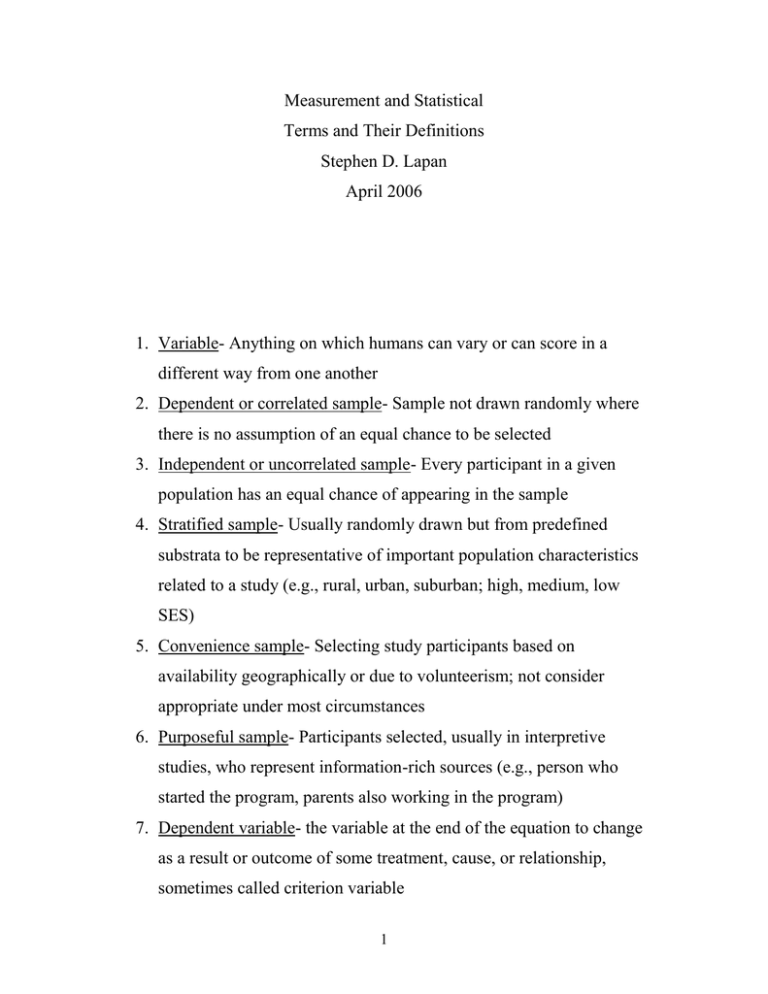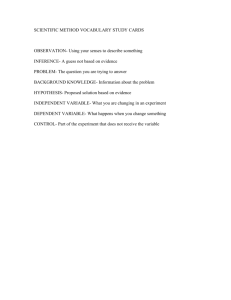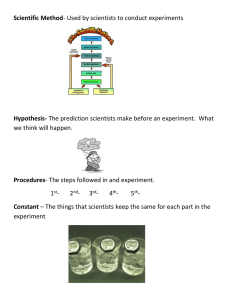Measurement and Statistical Terms and Their Definitions
advertisement

Measurement and Statistical Terms and Their Definitions Stephen D. Lapan April 2006 1. Variable- Anything on which humans can vary or can score in a different way from one another 2. Dependent or correlated sample- Sample not drawn randomly where there is no assumption of an equal chance to be selected 3. Independent or uncorrelated sample- Every participant in a given population has an equal chance of appearing in the sample 4. Stratified sample- Usually randomly drawn but from predefined substrata to be representative of important population characteristics related to a study (e.g., rural, urban, suburban; high, medium, low SES) 5. Convenience sample- Selecting study participants based on availability geographically or due to volunteerism; not consider appropriate under most circumstances 6. Purposeful sample- Participants selected, usually in interpretive studies, who represent information-rich sources (e.g., person who started the program, parents also working in the program) 7. Dependent variable- the variable at the end of the equation to change as a result or outcome of some treatment, cause, or relationship, sometimes called criterion variable 1 8. Independent variable- The treatment variable or variable manipulated or expected to make a difference in the outcome or dependent measure/variable. Usually classified as a treatment or moderator variable and sometimes called a predictor variable 9. Nominal or dichotomous scale or variable- Labels or category names (gender, sports jersey numbers) 10.Ordinal or ranked scale or variable- Objects or subjects are rated low to high without being able to determine distance between each rank . or scale point (e.g., Likert: strongly disagree= 1 to strongly agree= 5, if other 1-n labels called “Likert-type”) 11. Interval scale or variable- Objects or subjects are ranked from low to high and distance between each scale point is known (tests, performance measures) 12.Ratio scale or variable- Objects or subjects are ranked from low to high, distances between each scale point are known, and an absolute zero point can be determined so that a score of 100 may be considered twice that of 50 (weight, speed, time) 13. Rating scales- Instruments devised to measure the extent of some phenomenon in some “Likert” way (see #10) or using Semantic Differential (adjective pairs Love_ _ _Hate, Heavy_ _ _Light), Thurstone (fully identified scale points), or Guttman (accumulative scale points) 14.Coefficient- a score produced on a scale of +1.00 to -1.00 that represents the relationship between two or more variables for a group of subjects including but not limited to reliability coefficients, correlation coefficients, predictor-criterion coefficients, and 2 coefficients of determination (r , square of a correlation to indicated share variance) 15. t-test- Statistical test used when determining the difference between two measures on one group or differences between two groups. Used much less that in the past; replaced by structural equations (e.g., LISREL) 16. ANOVA- Analysis of Variance used when determining the statistical difference between more than two groups. Repeated ANOVA’s are used when groups are not randomly selected/assigned or ANCOVA (Analysis of Covariance) to statistically equate dependent samples on pretests before comparing on posttests 17. Factorial ANOVA- Determining statistical difference between more than two groups involving at least one manipulated variable and one or more moderator variables. MANOVA is used when more than one dependent variable is included in this arrangement and MANCOVA again to equate pretests for dependent samples 18. Degrees of freedom- Freedom to vary so that after a sample of N= 1 is drawn, each additional sample member has the opportunity to be different than the first or variation in result found from the first N. Thus, the degree to which a sample is free to vary is N-1. Moving down the left hand column of a probability table, the researcher selects the row that represents the number of subjects in the study minus one (some use the more conservative N-2) 19. Probability- Refers to sampling or chance of error (p= .01, p< .01, etc.). A probability sample is one drawn randomly so that every individual in the population has an equal chance of appearing in the sample. A probability table is used to determine the extent a particular 3 statistic produced in a study is considered statistically significant (e.g., p< .05). Also called alpha levels or levels of significance where the figure (.10, .05, .01, .001, etc.) refers to chances out of 100 or lower (<) that the relationship (r= correlation) or difference ( e.g., ANOVA or F) occurred by accident or chance 20. Level of significance or p value- See Probability above 21. Type I error- It is considered a research error of judgment combined with poor sampling that results in rejecting a null hypothesis (Ho= there is no significant relationship or difference) when the researcher should not have rejected it. That is, determining there is a significant relationship or difference when it is not warranted. This is ordinarily accomplished by setting an alpha to high, meaning setting the standard too low (e.g., p= .10). This also can result from the use of a less powerful statistical test such as a nonparametric measure. 22. Type II error- Setting the alpha level to low, meaning setting the standard too high (e.g., p=.01) where it is not warranted thus failing to reject the Ho when it should have been rejected. The researcher is doomed to commit one error or the other. Thus, the less likely you are to commit a Type I, the more likely you are to commit a Type II. Special note: Avoiding Type I errors is usually accomplished by using more powerful statistical tests and using a representative sample. But, it is also necessary to determine which error you would prefer to commit. Is new territory under investigation where exploratory efforts are warranted and thus any pattern of significance should be considered grounds for rejecting the Ho? Therefore, you would prefer to commit a Type I error. Or, is this a well-studied topic that needs more convincing confirmation, therefore 4 requiring more restrictive standards for significance and increasing the likelihood of committing a Type II error? A researcher chooses to take the chance of making one error or the other in reasoning how to set alpha levels (see chart). .10 .05 Incorrectly Reject .01 Incorrectly Accept Type I Type II Exploratory Explanatory Confirmatory Low Consequences Moderate High of finding significance consequences consequences Formative Intermediate Summative Rarely studied Some study Thoroughly studied 5





